clock CHEVROLET TRACKER 1998 1.G Owners Manual
[x] Cancel search | Manufacturer: CHEVROLET, Model Year: 1998, Model line: TRACKER, Model: CHEVROLET TRACKER 1998 1.GPages: 386, PDF Size: 21.17 MB
Page 128 of 386
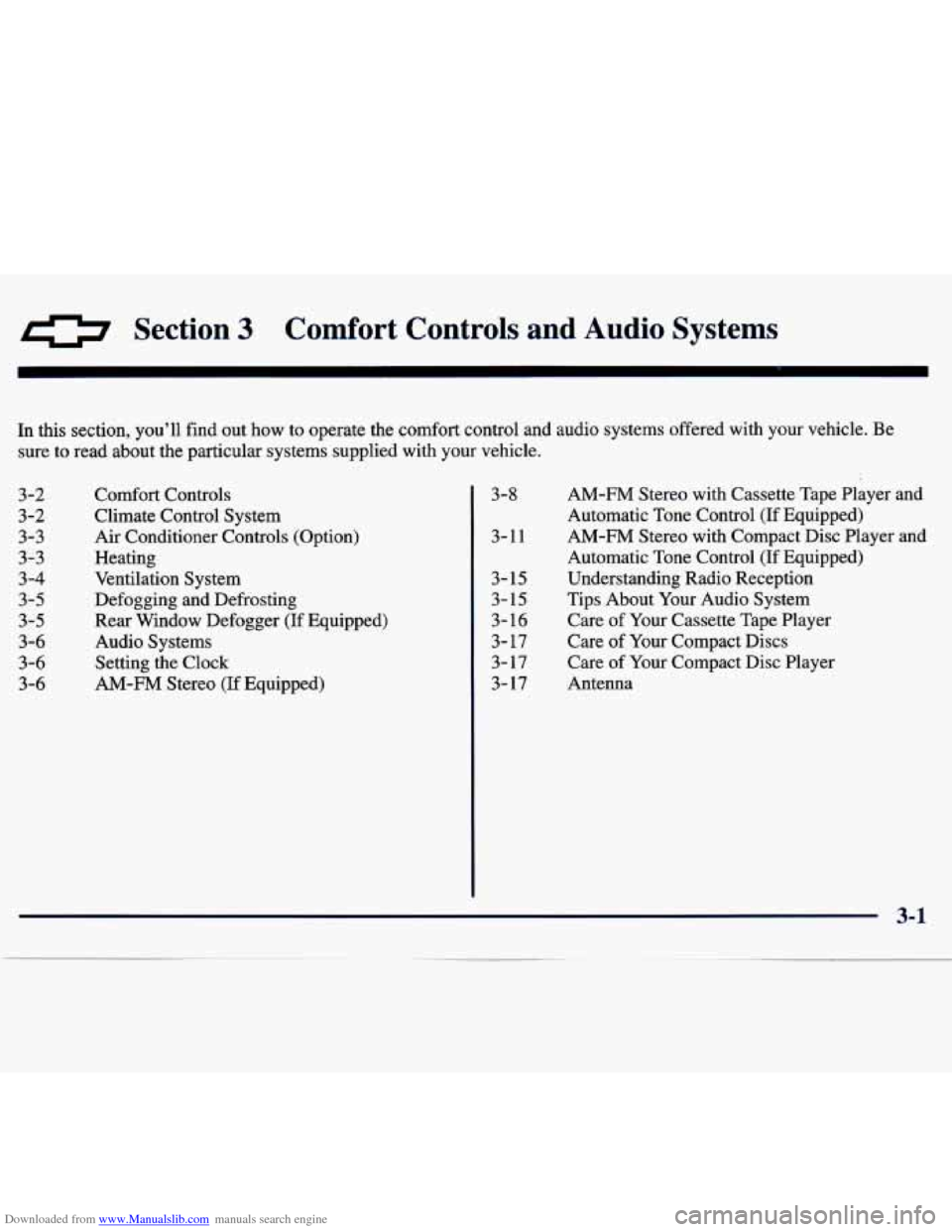
Downloaded from www.Manualslib.com manuals search engine 0 Section 3 Comfort Controls and Audio Systems
In this section, you'll find out how to operate the comfort control and audio systems offered w\
ith your vehicle. Be
sure to read about the particular systems supplied with your vehicle.
3-2
3-2
3-3 3-3
3-4
3-5
3-5 3-6
3-6
3-6 Comfort Controls
Climate Control
System
Air Conditioner Controls (Option)
Heating Ventilation System
Defogging and Defrosting Rear Window Defogger (If Equipped)
Audio Systems
Setting the Clock
AM-FM Stereo (If Equipped)
3-8 AM-FM Stereo with Cassette Tape Player and
Automatic Tone Control
(If Equipped)
Automatic Tone Control
(If Equipped)
3-11 AM-FM
Stereo with Compact Disc Player and
3- 15 Understanding Radio Reception
3- 15 Tips About Your Audio System
3- 16 Care
of Your Cassette Tape Player
3- 17 Care of Your Compact Discs
3-17 Care of Your Compact Disc Player
3- 17 Antenna
J'
Page 133 of 386
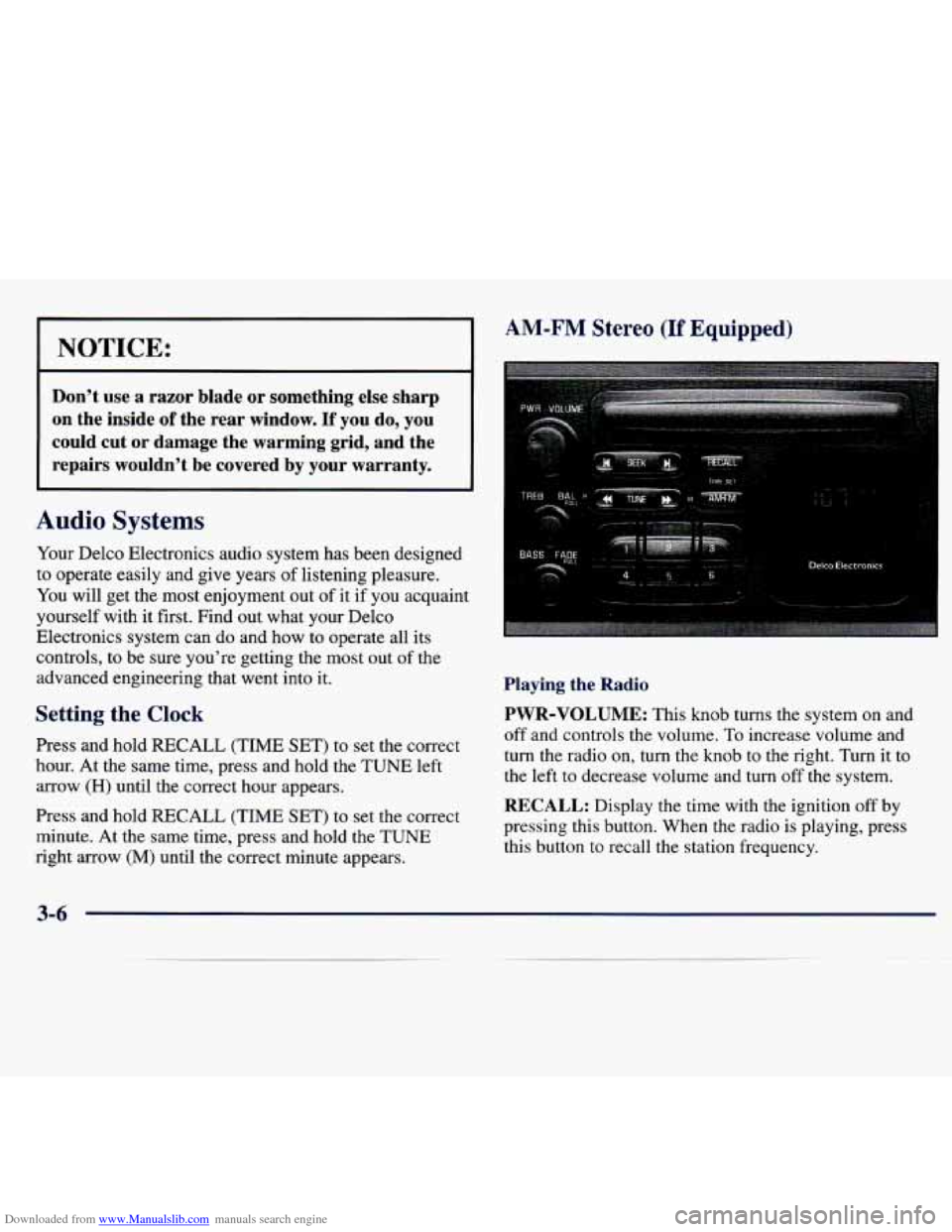
Downloaded from www.Manualslib.com manuals search engine NOTICE:
Don't use a razor blade or something else sharp on the inside
of the rear window. If you do, you
could cut or damage the warming grid, and the
repairs wouldn't be covered
by your warranty.
Audio Systems
Your Delco Electronics audio system has been designed
to operate easily and give years
of listening pleasure.
You will get the most enjoyment out
of it if you acquaint
yourself with it first. Find out what your Delco
Electronics system can do and how to operate all its
controls, to be sure you're getting the most out of the
advanced engineering that went into it.
Setting the Clock
Press and hold RECALL (TIME SET) to set the correct
hour. At the same time, press and hold the TUNE left arrow
(H) until the correct hour appears.
Press and hold
RECALL (TIME SET) to set the correct
minute. At the same time, press and hold the TUNE
right arrow
(M) until the correct minute appears.
AM-FM Stereo (If Equipped)
Playing the Radio
PWR-VOLUME:
This knob turns the system on and
off and controls the volume. To increase volume and
turn the radio on, turn the knob to the right. Turn it to
the left to decrease volume and
turn off the system.
RECALL: Display the time with the ignition off by
pressing this button. When the radio
is playing, press
this button to recall the station frequency.
3-6
Page 156 of 386
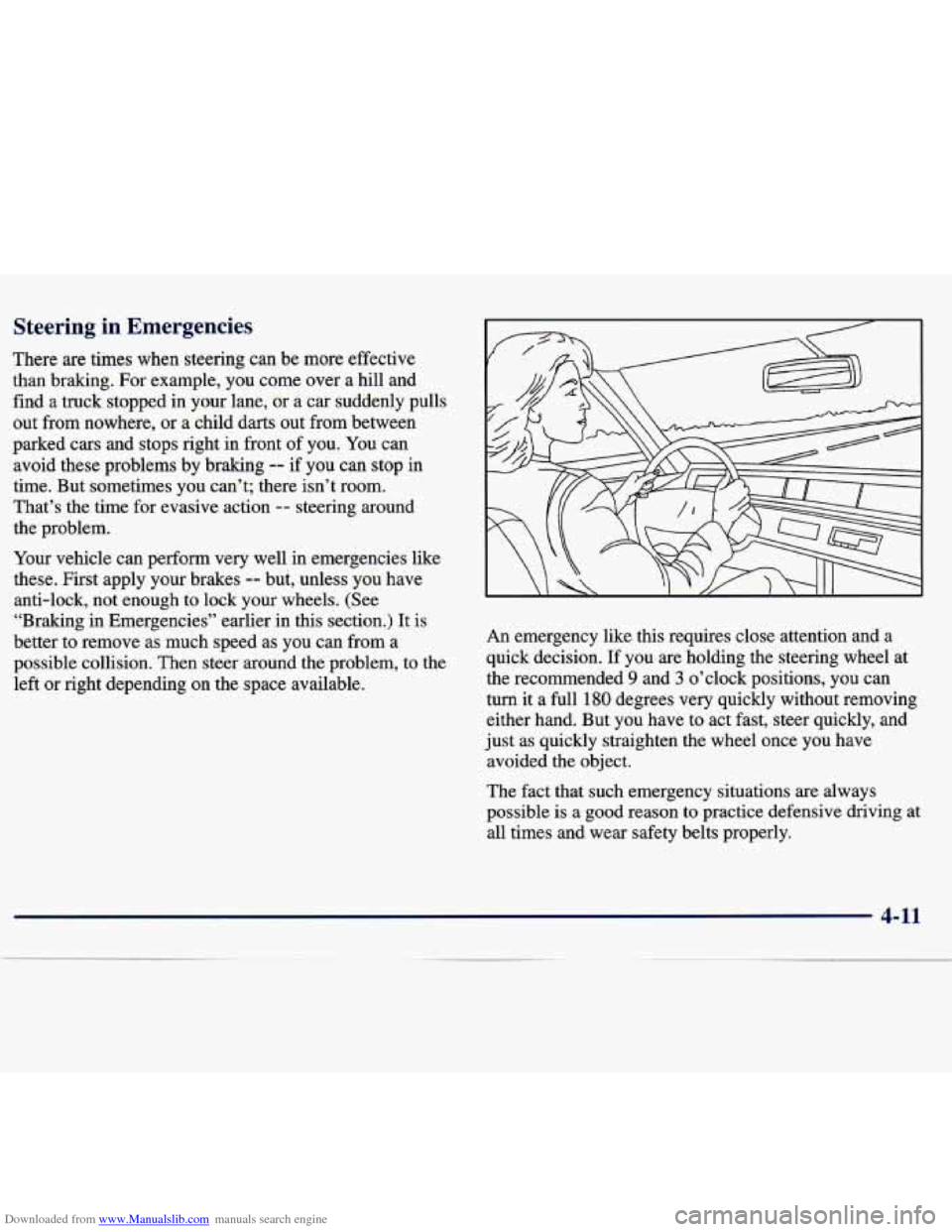
Downloaded from www.Manualslib.com manuals search engine Steering in Emergencies
There are times when steering can be more effective
than braking. For example, you come over a hill and
find a truck stopped in your lane,
or a car suddenly pulls
out from nowhere, or
a child darts out from between
parked cars and stops right in front of you.
You can
avoid these problems by braking
-- if you can stop in
time. But sometimes you can’t; there isn’t room.
That’s the time for evasive action
-- steering around
the problem.
Your vehicle can perform very well in emergencies like
these. First apply your brakes
-- but, unless you have
anti-lock, not enough to lock your wheels. (See
“Braking in Emergencies” earlier in this section.) It is
better to remove as much speed as you can from a
possible collision. Then steer around the problem, to the
left or right depending on the space available.
An emergency like this requires close attention and a
quick decision. If you are holding the steering wheel at
the recommended
9 and 3 o’clock positions, you can
turn it a full
180 degrees very quickly without removing
either hand. But you have to act fast, steer quickly, and
just as quickly straighten the wheel once you have
avoided the object.
The fact that such emergency situations are always
possible is a good reason to practice defensive driving at
all times and wear safety belts properly.
Page 167 of 386
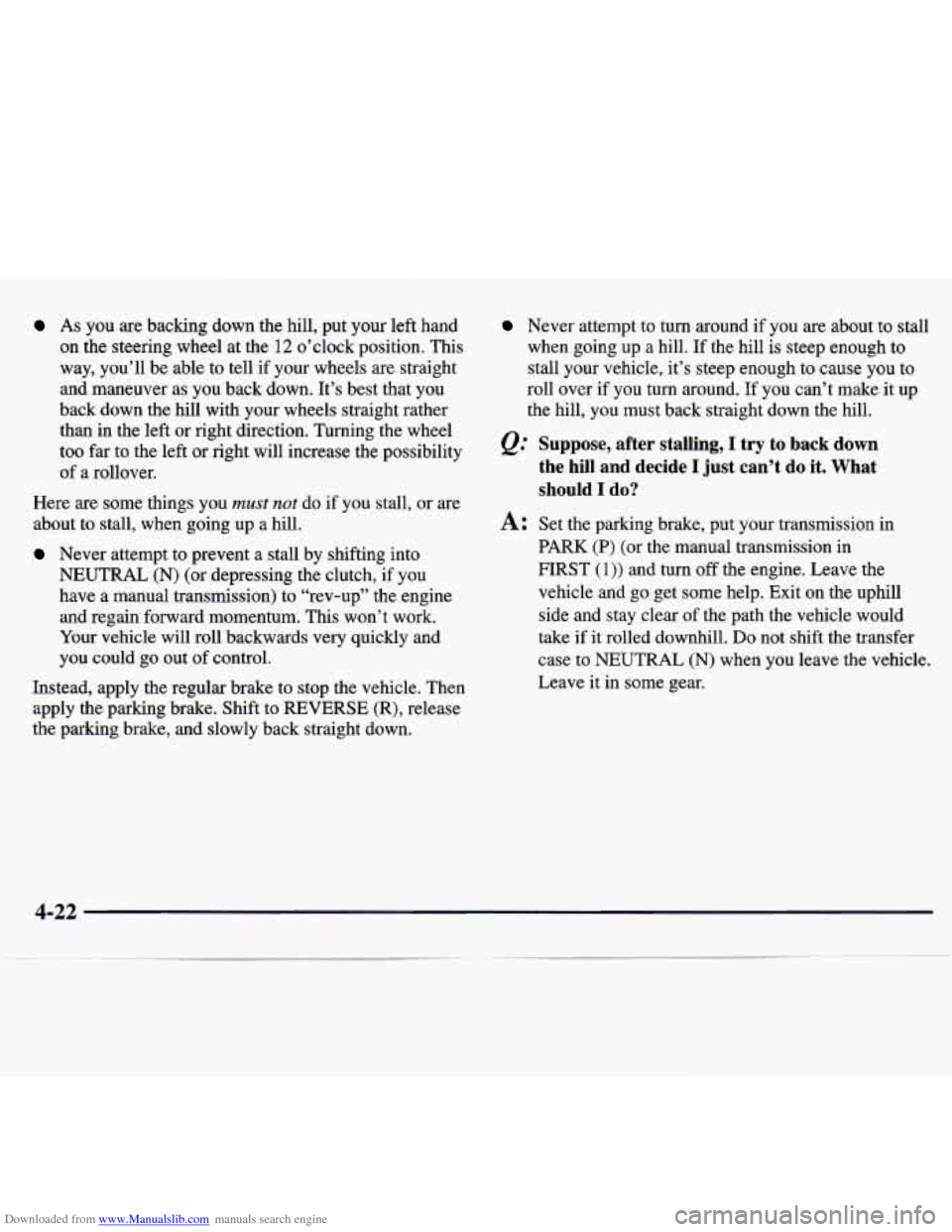
Downloaded from www.Manualslib.com manuals search engine As you are backing down the hill, put your left hand
on the steering wheel at the
12 o’clock position. This
way, you’ll be able to tell if your wheels are straight
and maneuver as you back down. It’s best that you
back down the hill with your wheels straight rather
than in the left or right direction. Turning the wheel
too far to the left or right will increase the possibility
of a rollover.
Here
are some things you must nut do if you stall, or are
about to stall, when going up a hill.
Never attempt to prevent a stall by shifting into
NEUTRAL
(N) (or depressing the clutch, if you
have a manual transmission) to “rev-up” the engine
and regain forward momentum.
This won’t work.
Your vehicle will roll backwards very quickly and
you could go out of control.
Instead, apply the regular brake to stop the vehicle. Then apply the parking brake. Shift to
REVERSE (R), release
the parking brake, and slowly back straight down.
Never attempt to turn around if you are about to stall
when going up a hill. If the hill is steep enough to
stall your vehicle, it’s steep enough to cause you to
roll over if you turn around.
If you can’t make it up
the hill, you must back straight down the hill.
Suppose, after stalling, I try to back down
the hill and decide
I just can’t do it. What
should
I do?
A: Set the parking brake, put your transmission in
PARK
(P) (or the manual transmission in
FIRST
(1)) and turn off the engine. Leave the
vehicle and go get some help. Exit on the uphill side and stay clear of the path the vehicle would
take if it rolled downhill. Do not shift the transfer
case to NEUTRAL, (N) when you leave the vehicle.
Leave it in some gear.
4-22
Page 220 of 386
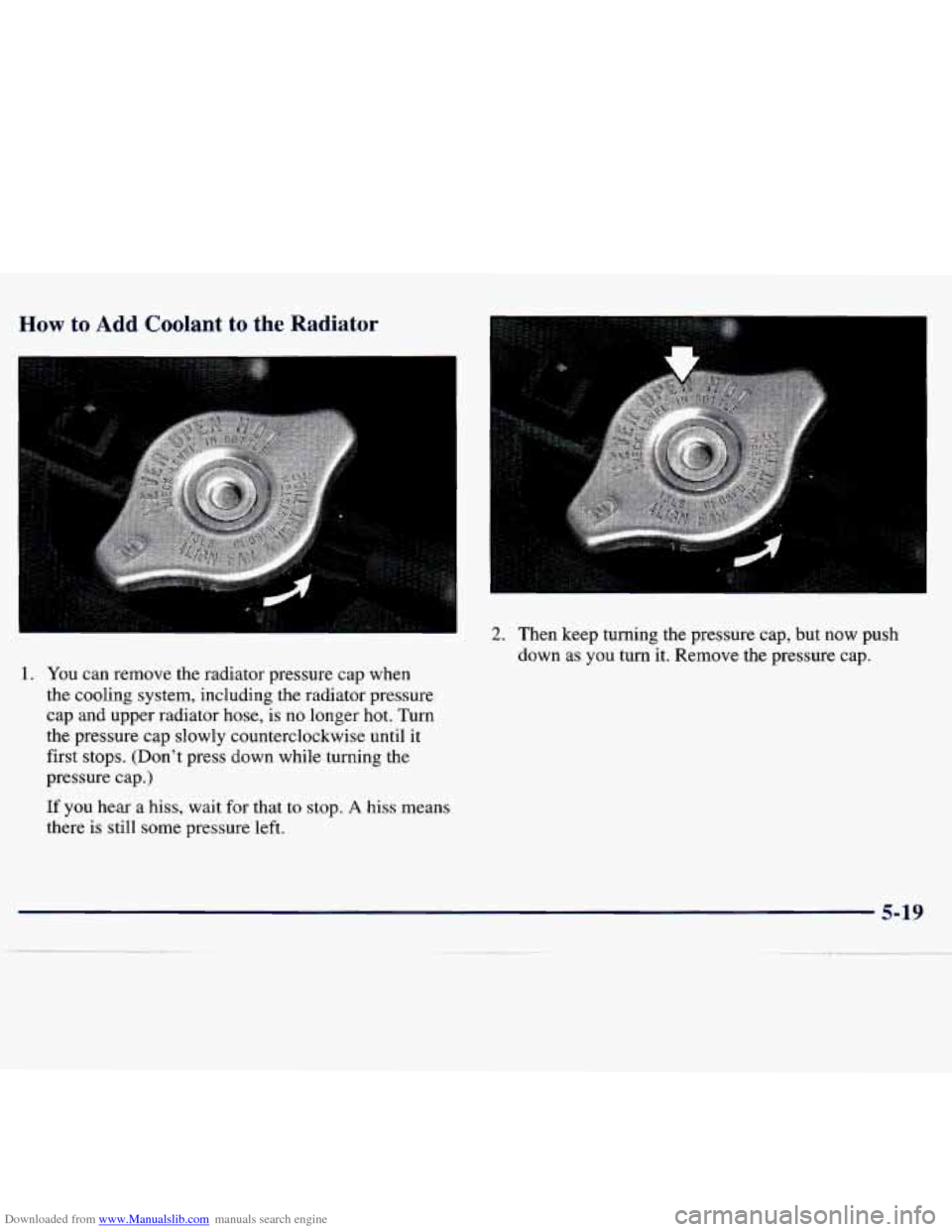
Downloaded from www.Manualslib.com manuals search engine How to Add Coolant to the Radiator
I
1. You can remove the radiator pressure cap when
the cooling system, including the radiator pressure
cap and upper radiator hose, is no longer hot. Turn
the pressure cap slowly counterclockwise until it
first stops. (Don’t press down while turning the
pressure cap.)
If you hear a hiss, wait for that to stop.
A hiss means
there is still some pressure left.
2. Then keep turning the pressure cap, but now push
down as you turn it. Remove the pressure cap.
5-19
Page 243 of 386
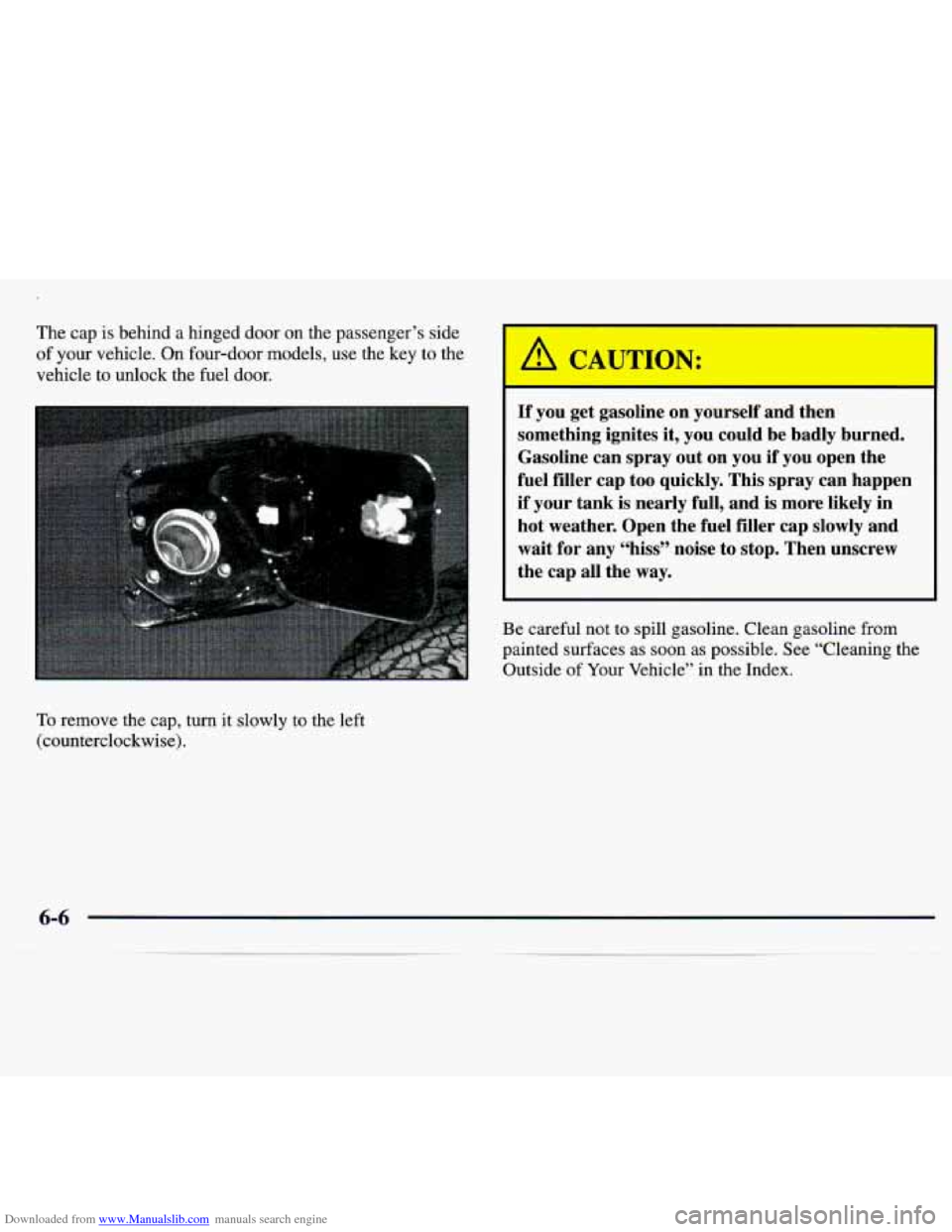
Downloaded from www.Manualslib.com manuals search engine The cap is behind a hinged door on the passenger’s side
of your vehicle. On four-door models,
use the key to the
vehicle to unlock
the fuel door.
To remove the cap, turn it slowly to the left
(counterclockwise).
I a CAUTION:
If you get gasoline on yourself and then
something ignites it, you could be badly burned.
Gasoline can spray out on you
if you open the
fuel filler cap too quickly. This spray can happen
if your tank is nearly full, and is more likely in
hot weather. Open the fuel filler cap slowly and
wait for any “hiss” noise to stop. Then unscrew
the cap all the way.
Be careful not to spill gasoline. Clean gasoline
from
painted surfaces as soon as possible. See “Cleaning the
Outside
of Your Vehicle” in the Index.
6-6
Page 244 of 386
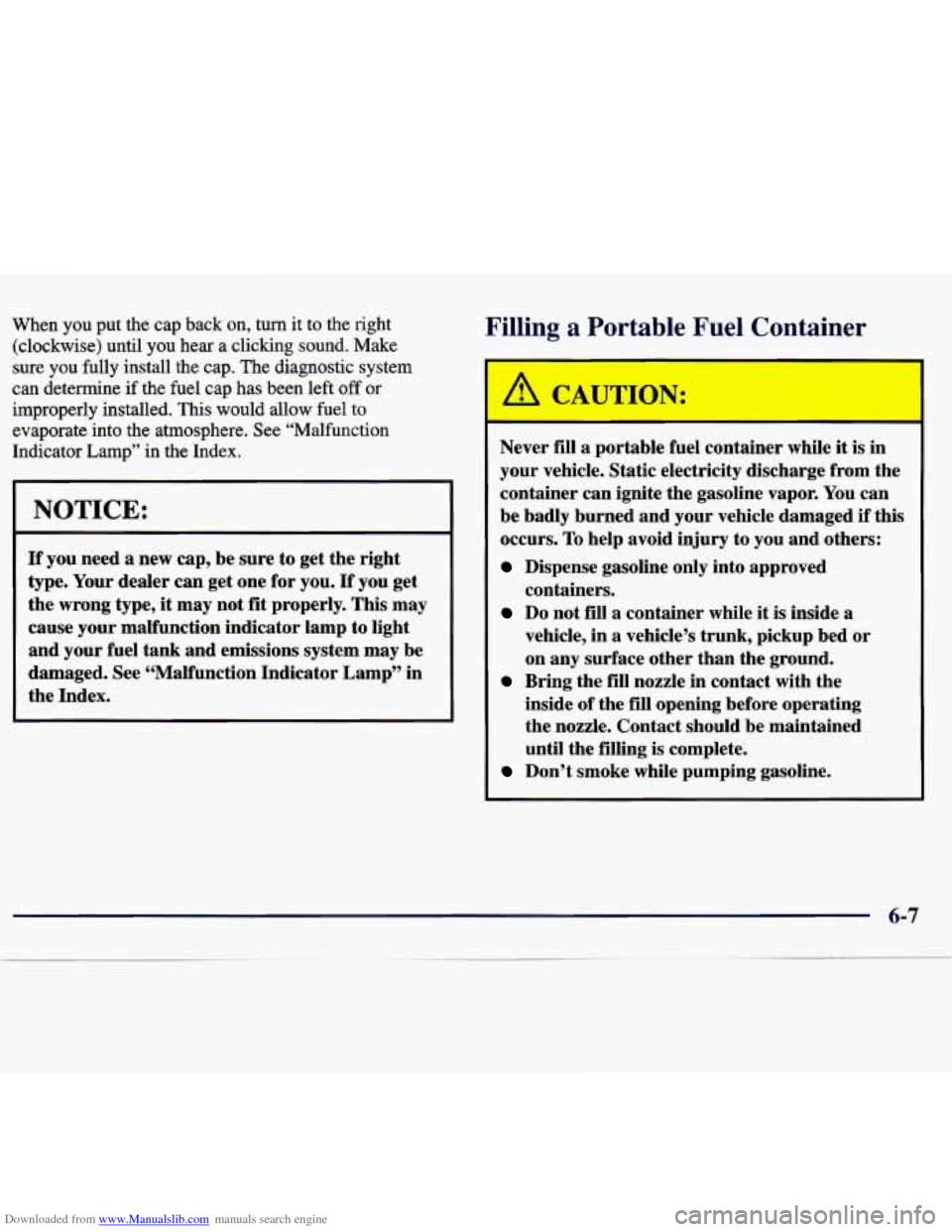
Downloaded from www.Manualslib.com manuals search engine When you put the cap back on, turn it to the right
(clockwise) until you hear a clicking sound. Make
sure you fully install the cap.
The diagnostic system
can determine
if the fuel cap has been left off or
improperly installed. This would allow fuel to
evaporate into the atmosphere. See “Malfunction
Indicator Lamp” in the Index.
NOTICE:
If you need a new cap, be sure to get the right
type. Your dealer can get one for you. If you get
the wrong type,
it may not fit properly. This may
cause your malfunction indicator lamp to light
and your fuel tank and emissions system may be
damaged. See “Malfunction Indicator Lamp’’ in
the Index.
Filling a Portable Fuel Container
A CAU ,ION:
Never fill a portable fuel container while it is in
your vehicle. Static electricity discharge from the
container can ignite the gasoline vapor.
You can
be badly burned and your vehicle damaged
if this
occurs. To help avoid injury to you and others:
Dispense gasoline only into approved
containers.
Do not fill a container while it is inside a
vehicle, in
a vehicle’s trunk, pickup bed or
on any surface other than the ground.
inside of the fill opening before operating
the nozzle. Contact should be maintained
until the filling is complete.
Bring the fill nozzle in contact with the
Don’t smoke while pumping gasoline.
Page 375 of 386
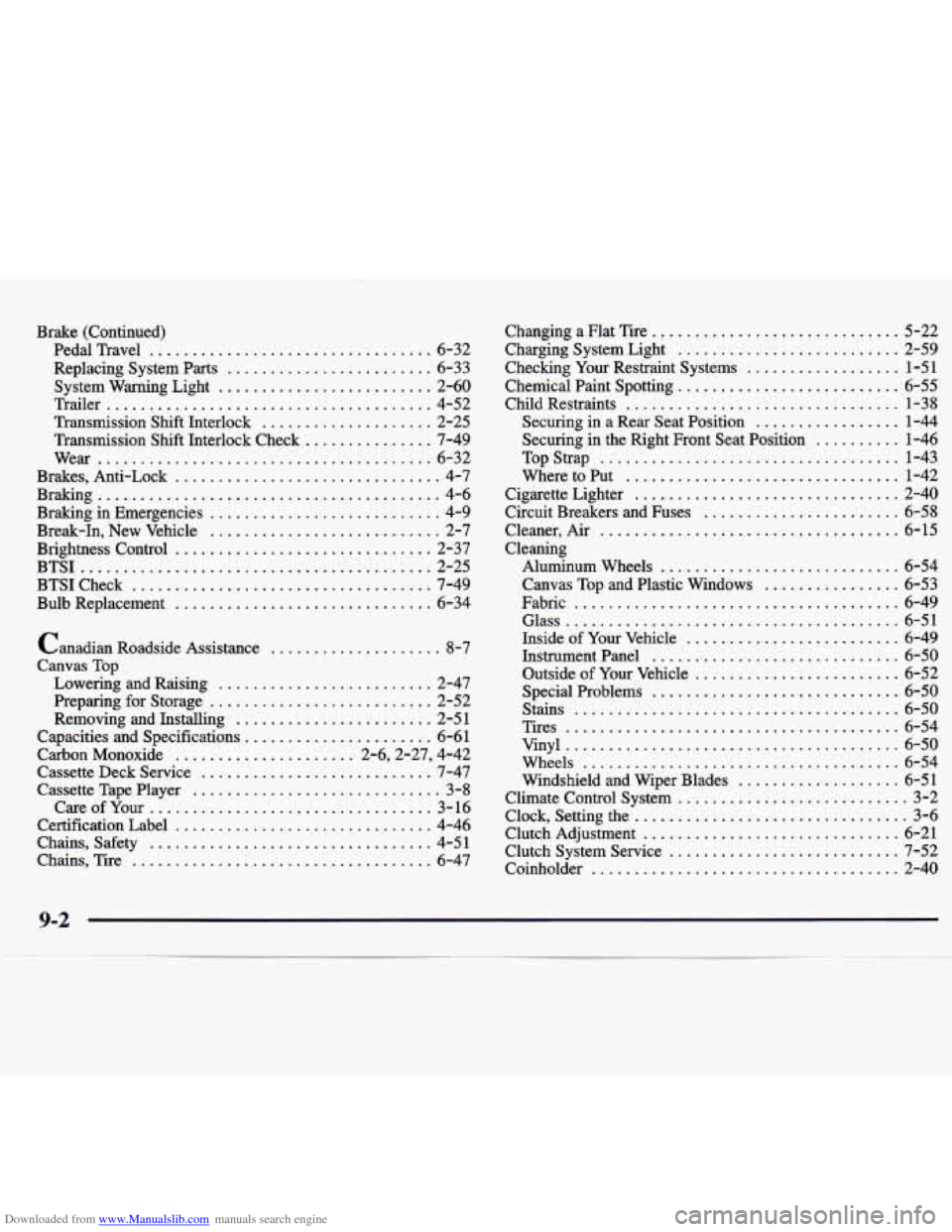
Downloaded from www.Manualslib.com manuals search engine Brake (Continued) Pedal Travel
................................. 6-32
Replacing System Parts
........................ 6-33
System Warning Light
......................... 2-60
Trailer
...................................... 4-52
Transmission Shift Interlock
.................... 2-25
Transmission Shift Interlock Check
............... 7-49
Wear
....................................... 6-32
Brakes. Anti-Lock
............................... 4-7
Braking in Emergencies
........................... 4-9
Break-In. New Vehicle
........................... 2-7
Brightness Control
.............................. 2-37
BTSICheck
................................... 7-49
Bulb Replacement
.............................. 6-34
Braking
........................................ 4-6
BTSI
......................................... 2-25
Canadian Roadside Assistance
.................... 8-7
Canvas Top
Lowering and Raising
......................... 2-47
Preparing for Storage
.......................... 2-52
Removing and Installing
....................... 2-51
Capacities and Specifications
...................... 6-61
Carbon Monoxide
..................... 2.6.2.27. 4.42
Cassette Deck Service
........................... 7-47
Cassette Tape Player
............................. 3-8
CareofYour
................................. 3-16
Certification Label
.............................. 4-46
Chains. Safety
................................. 4-51
Chains. Tire
................................... 6-47 Changing a Flat Tire
............................. 5-22
Charging System Light
.......................... 2-59
Checking Your Restraint Systems
.................. 1-51
Chemical Paint Spotting
.......................... 6-55
Child Restraints
................................ 1-38
Securing in a Rear Seat Position
................. 1-44
Securing in the Right Front Seat Position
.......... 1-46
Top Strap
................................... 1-43
Where to Put
................................ 1-42
Cigarette Lighter
............................... 2-40
Circuit Breakers and Fuses
....................... 6-58
Cleaner. Air
................................... 6-15
Cleaning Aluminum Wheels
............................ 6-54
Canvas Top and Plastic Windows
................ 6-53
Fabric
...................................... 6-49
Glass ....................................... 6-51
Inside of Your Vehicle
......................... 6-49
InstrumentPanel
............................. 6-50
Outside of
Your Vehicle ........................ 6-52
Special Problems
............................. 6-50
Stains
...................................... 6-50
Tires
....................................... 6-54
Vinyl
....................................... 6-50
Wheels
..................................... 6-54
Windshield and Wiper Blades
................... 6-51
Climate Control System
........................... 3-2
Clock. Setting the
................................ 3-6
Clutch Adjustment
.............................. 6-21
Clutch System Service
........................... 7-52
Coinholder
.................................... 2-40